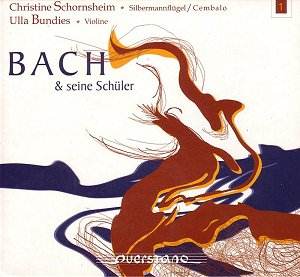Johann Sebastian Bach
was one of the first composers to give
the harpsichord a concertato role in
his chamber music. Others followed in
his footsteps. This recording is the
first in a series of three which will
contain the six sonatas for harpsichord
and violin by Bach. In addition sonatas
are performed which follow his example.
On this first disc in the series the
first two of Johann Sebastian’s six
sonatas are combined with a sonata by
his son Carl Philipp Emanuel and one
by his pupil Johann Philipp Kirnberger.
The result is very
interesting, in that it shows the differences
and similarities between them. Whereas
in Johann Sebastian Bach's sonatas the
musical material of keyboard and violin
is closely connected, with a lot of
imitation and forms like canon and fugue,
Carl Philipp Emanuel gives them more
independence. One of the most striking
examples is the first movement (adagio)
of the Sonata in b minor. Both instruments
express their own ideas, but gradually
the violin takes over those of the keyboard.
Another feature of this sonata is the
fact that there are more and longer
passages where the keyboard is playing
alone, in comparison with Johann Sebastian's
sonatas, where those passages don't
take more than a couple of bars.
Johann Philipp Kirnberger
was a pupil of Johann Sebastian Bach
between 1739 and 1741. He acted as a
violinist at the court in Berlin from
1751 - 1754 and from 1758 until his
death he was curator of the music library
of Princess Anna Amalia. Kirnberger
was a vehement defender and propagandist
of Bach's music and style. In the liner
notes Peter Wollny writes: "Kirnberger
saw the discovery of the secrets of
Bach's genius as his life's prime purpose
and vocation."
His sonata in E links
up quite strongly with the sonatas of
his teacher. The first two movements
do sound a lot like those of the old
Bach. But it is also a sonata with two
faces: the next two movements (polonaise
and menuet) are much more light-weight,
typically galant pieces.
I have mixed feelings
in regard to the interpretation by Christine
Schornsheim and Ulla Bundies. Two keyboard
instruments are used: a harpsichord
by Christoph Kern, "copy based on an
instrument by Michael Mietke", as the
booklet says. But that is not quite
the same as what the original German
text says: "free after an instrument
of". This means it is not really a copy,
but an instrument 'in the style of'.
That is a choice one may support or
reject, but one shouldn’t call a copy
what in fact isn't a real copy. The
harpsichord is not, as one would expect,
used in both sonatas by Johann Sebastian
Bach, but only in his Sonata I and in
the sonata by Kirnberger.
The other instrument
is a fortepiano, a copy of an instrument
which was built in 1749 by Gottfried
Silbermann. This is the right instrument
for the sonata by Carl Philipp Emanuel
Bach which dates from 1763. But to perform
Johann Sebastian's Sonata II on this
fortepiano is historically unjustifiable,
since Bach's sonatas date from the 1720's.
This is not just a
matter of what is 'historically right'.
The actual performance is unsatisfying.
On this disc the balance between the
instruments is very good - with the
exception of this sonata. Here the violin
dominates, since the descant of the
fortepiano is not as penetrating as
that of the harpsichord. In the third
movement the score asks for 'staccato
sempre' in the left hand. On the fortepiano
this makes much less sense, because
its sounds ring through longer than
that of the harpsichord.
There is certainly
a lot to enjoy in this recording. The
second movement of Carl Philipp Emanuel
Bach's sonata is a typical example of
the 'Empfindsamkeit', and its character
is realised very well here. And the
sonata by Kirnberger is given a fine
performance. The rhythm of the polonaise
is nicely accentuated.
On the other hand,
there is too little variety in the treatment
of the notes. A less straightforward
approach would have made this performance
more interesting. In the first movement
of Carl Philipp Emanuel's sonata the
playing of Christine Schornsheim is
so mechanical that it made me think
of a rattling alarm. The tempo here
is too fast considering the indication
of 'allegro moderato'.
This is not a boring
recording in any way, but it could have
been much better with a less straightforward
approach and a less arbitrary choice
of keyboard instruments.
Johan van Veen


